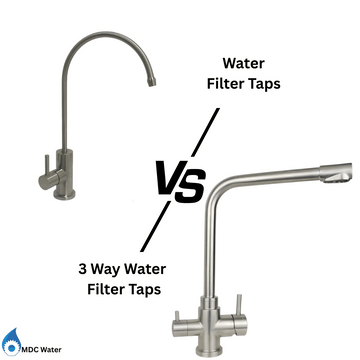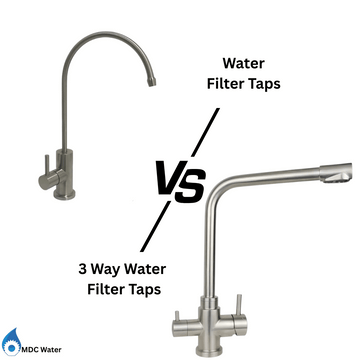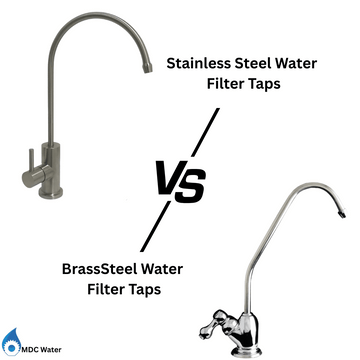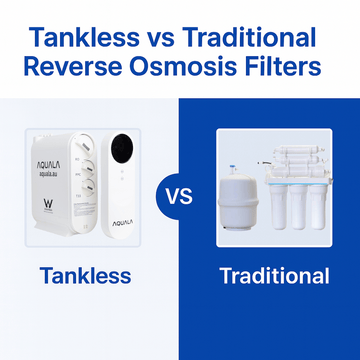Australians love the taste and peace of mind of filtered water, but the big decision is how to get it to the sink. Do you add a separate filtered water faucet beside your main mixer, or upgrade to a sleek 3 way mixer tap that delivers hot, cold, and filtered water from one spout? This guide explains both options so you can pick the best fit for your kitchen layout, budget, and lifestyle.
What Is a Separate Filtered Water Tap?
A separate water filter tap (also called a filtered water faucet, filtration faucet, or tap water filter faucet) is a compact second faucet installed on your sink or benchtop. It connects to your under-sink filter (carbon, RO, or multi-stage), and dispenses filtered, room-temperature water independently of your main mixer.
How it works: The filter’s clean water outlet runs to the dedicated tap via small tubing. Turn the handle and only the water you drink or cook with is filtered, great for cartridge life and taste consistency.
Pros:
-
Simple add-on: Keep your existing mixer. If your sink has a spare knock out or soap dispenser hole, installation can be fast.
-
Budget-friendly: Basic stainless filter for faucet models are cheaper than a full 3 way kitchen mixer tap.
Cons
-
Needs an extra hole: If the sink/bench doesn’t have one, you’ll need to drill (trickier for stone tops or rentals).
-
More clutter: A second spout can disrupt a minimalist look or crowd a tight sink.
-
Style mismatch risk: If you don’t choose a matching finish, it can look “added on.”
Want options? Browse our curated Filtered Water Taps collection or view our best-seller: the Stylish Stainless Steel Water Filter Tap.
What Is a 3-Way Mixer Tap?
A 3 way mixer tap (aka tri-flow or 3 in 1 mixer) combines three water lines, hot, cold, and filtered, into a single faucet with separate internal channels so filtered water never mixes with mains. Usually, one lever controls hot/cold; a second lever/button dispenses the filtered stream.
How it works: You replace your existing mixer with a 3 way kitchen mixer tap. Your filter’s outlet connects to the tap’s dedicated filtered inlet. One spout, three water options.
Pros
-
Sleek & space-saving: One spout keeps the bench clean, no extra hole, no clutter.
-
Effortless everyday use: Fill a pot with filtered water, then swing to hot for cooking, no swapping taps.
-
No drilling: Ideal for stone benches or sinks with a single hole.
-
Premium look & feel: Modern designs (including 3 way mixer tap with pull out) complement designer kitchens.
Cons
-
Higher upfront cost: More complex hardware and finishes cost more than a basic filter tap.
-
Install is a swap over: You’re replacing the main mixer and connecting three lines, usually a quick job for a plumber.
Explore our 3-Way Mixer Taps, the 3-Way Mixer Tap – Stainless Steel, and our popular 3-Way Mixer Tap with Pull-Out.
Side-by-Side Comparison
| Factor | Separate Filtered Water Faucet | 3 Way Mixer Tap |
|---|---|---|
| Upfront cost | Lower $75-120 | Higher $300-700 |
| Space & holes | Needs an extra sink/bench hole | Uses existing hole; no drilling |
| Convenience | Two spouts to juggle | One spout, three functions |
| Aesthetics | Can look “added on” | Seamless, minimalist |
| Flow | Filtered stream is typically slower | Mains hot/cold full flow; filtered gentle |
| Maintenance | Simple; faucet is basic | Simple; faucet is basic |
| Installation | Easy if a spare hole exists | Swap-over of main mixer; usually best done by a plumber |
| Rental friendliness | Tougher (drilling limits) | Often easier (no extra hole, reversible) |
Which One Fits Aussie Kitchens Best?
Apartment renters: Landlords rarely approve drilling stone benches. A 3 way tap is often the least invasive, using the existing hole and reversing easily when you move out. Keep the original mixer to reinstall later.
Homeowners: If you’re renovating (or your old mixer is due for retirement), upgrade to a 3 way mixer tap for the cleanest look and daily convenience. If you love your mixer or want a very low cost path to filtered water, a separate filtered water faucet is a smart step.
Small kitchens & pantries: Go integrated. One spout declutters compact sinks and makes daily hydration frictionless.
Large kitchens: Both shine. Use a separate filtration faucet on a prep/bar sink or choose a premium 3 way kitchen mixer tap in your main zone for a cohesive, high-end finish.
Budget vs premium finishes: On a tight budget, a separate water filter tap delivers filtered water without the bigger outlay. If you want a design upgrade (brushed, matte black, brass tones) and a future proof centrepiece, invest in a 3 way mixer tap especially a 3 way mixer tap with pull out for chef-level versatility.
Compliance: Whatever you choose, ensure the tap is WaterMark certified for Australian plumbing standards. It protects your warranty, insurance, and peace of mind.
Our Recommendation: Stainless Steel Water Filter Taps
Whether you pick a separate filtration faucet or a 3 way tap, the material matters. We recommend solid stainless steel over cheap brass cores.
Why stainless wins
-
Lead-free by design: Stainless is inherently lead-free; many brass fixtures are only “low lead.” For a drinking-water path, stainless is the safer bet.
-
Built to last: 304 food-grade stainless resists corrosion and pitting, ideal for filtered water pathways and daily kitchen use.
-
Neutral taste: Stainless won’t impart metallic flavours or odours, protecting the crisp profile your filter creates.
-
Premium finishes: Modern PVD finishes on stainless (brushed steel, matte black, gunmetal, brass tones) are durable and easy-care.
See the range: Filtered Water Taps collection
Hero pick: Stylish Stainless Steel Water Filter Tap (solid 304 stainless, 360° swivel, multiple finishes)
Integrated picks: 3-Way Mixer Taps including the 3-Way Mixer Tap – Stainless Steel and 3-Way Mixer Tap with Pull-Out
FAQs
Do I need a plumber to install a water filter tap or 3-way mixer?
If your sink already has a spare hole, many handy homeowners can DIY a separate water filter tap. For stone drilling or any mains connection, we recommend a licensed plumber. A 3 way mixer tap replaces your main mixer and connects three lines, so a plumber is the safest, most compliant route, and usually a quick visit.
Are 3 way mixer taps worth the extra money?
If you value a clean benchtop, one tap convenience, and a premium look, yes. Daily usability improves, no switching spouts, no clutter. If budget is tight, a separate filtered water faucet is still an excellent way to get better water now.
Can I upgrade later if I start with a separate filtered faucet?
Absolutely. Keep your under-sink system. When you’re ready, install a 3 way kitchen mixer tap and connect the filter outlet to the new tap’s filtered inlet (most include adapters). Remove or repurpose the extra hole for a soap dispenser.
Will a 3 way mixer deliver the same filtered quality?
Yes, quality is determined by your under sink system. A 3 way tap keeps the filtered channel isolated from mains through separate internal pathways, preserving purity all the way to the spout.
Conclusion
Both options deliver what matters most: clean, great-tasting water on demand. Choose a filtered water faucet if you want the fastest, most affordable path to better drinking water and don’t mind an extra spout. Choose a 3 way mixer tap if you prefer one elegant faucet, zero bench clutter, and maximum everyday convenience, especially in modern kitchens or rentals where drilling is a no-go.
Whichever route you take, insist on WaterMark certification and solid stainless steel for a hygienic, durable, and taste-neutral solution.
Ready to decide?
-
Compare designs in our Filtered Water Taps collection.
-
See our stainless hero: Stylish Stainless Steel Water Filter Tap.
-
Prefer integrated? Explore 3-Way Mixer Taps, including the 3-Way Mixer Tap – Stainless Steel and 3-Way Mixer Tap with Pull-Out.
Upgrade once, enjoy every glass. Clean, filtered water, delivered your way.




